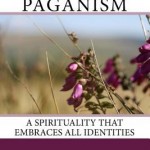Over the past few years of teaching theology to Pagans, I’ve slowly stopped applying theological “-ist” labels to myself. My theology has evolved throughout my life and isn’t likely to stop. Moreover, at least in the Pagan movement (which tends to attract spiritual experimenters and explorers), having an evolving theology is the norm. When I teach theology, one of my students’ assignments is to go out into their communities and interview others about their beliefs and practices. Over the years, this assignment has produced a fairly clear portrait of contemporary Pagans as people whose beliefs are actively and self-consciously in process, not pinned down in a set of rigid doctrines that cannot be questioned. Even more exciting have been the opportunities to watch my students’ beliefs change as they encounter ideas and approaches that are new to them. When I put together some of my class materials into an introductory book on Pagan theologies, I called it Seeking the Mystery because no one system of thought can ever encompass the totality of our spiritual experiences or our evolving knowledge of divinity, however we understand She/He/It/Them. That necessary incompleteness is the mystery that keeps us engaged and ever open to revising our perspectives.
Accordingly, I tend to say things like “I have ***-istic beliefs and practices” rather than to say “I am a(n) ***-ist.” It feels more honest, and it also helps me avoid situations where potential co-religionists want me to produce my theological ID card, to make sure I’m a “real” -ist before they’ll listen to me speak or read my work. I’m also fairly private about my personal practice and my relationships with other-than-human persons; if I make no claim to embodying any particular theological viewpoint, I find, people tend to be a bit less inquisitive about the details. (That being said, I was interviewed under a different name in a recently published ethnography of modern polytheism. Any regular reader of this blog who is sufficiently curious will probably have no trouble identifying me there.)
When I teach, I do my best to downplay my personal beliefs, since my aim is to help students think critically and encounter texts and ideas with minimal bias from me. Here’s the secret truth, though: of the maybe two dozen books and essays we look at in my introductory theology class, my favorite is Raven Kaldera’s Dealing with Deities.
It’s not the most academic of the books–in fact, it may be one of the least. It doesn’t have footnotes, and it doesn’t make any claim to scholarly authority, nor does it attempt to lay out a doctrine for all Pagans or all polytheists. It’s based on experience and written conversationally, accessibly, engagingly, compassionately. And, frustratingly, when students come to my class, it’s rare that any of them have ever heard of it.
Although I’ve recommended Kaldera’s work in my books, here on this blog, over at the Harvard Pluralism Project site, on the Seeker channel here at Patheos, and elsewhere, Dealing with Deities is still much less well known than I think it deserves. Rather than writing a traditional review, however, I’d like to simply post a few excerpts, in the hopes that readers will be intrigued enough to pick up a copy and read more.
The conflict-avoidant pick-your-own-truth [approach] is great for personal spiritual practice if one intends to be an eternal solitary practitioner―and, to be fair, there’s nothing wrong with that path and many people are called to it―but truths (and I deliberately use the plural for this word) have always created conflicts. Fear of proposing any absolute doctrines―or even doctrines predicated on accepting specific beliefs for the moment because they seem to work―means that one does not dare to explore serious questions about how the Gods and the Universe functions. In the other direction, there are gaps in the meager surviving written records of the ancients that leave large holes in how those serious questions were seen in their faith[.…] Without comparing the divine inspiration of a great number of believers, we cannot begin to fill in those gaping holes. The assumption that the Gods no longer speak to human beings, and that they cannot understand the modern human situation, discounts the living faith experience of thousands of people.
So how do we begin to construct a theology that is authentic to our experiences, as polytheists, of how the Universe works? We can start by finding a middle ground, where we keep an open mind and are able to entertain the idea of change … and at the same time, we are on the lookout for corroborating information, whether from ancient or modern sources. We can also start by talking about our beliefs and experiences, and listening to each other even when we are disagreeing. (5)
At one point in the past, a group of archetypists rented my back field to do their ritual. They were polite and didn’t leave trash around, so I was fine with letting them have it. Out of courtesy, they invited me to attend, and gave me a copy of the ritual to peruse. As I read their very archetypist view of the Gods, complete with ordering them down to give various favors and conflating large groups of deities from different cultures who barely resembled each other, I wondered if I should attend. The voice from my patron deity came immediately: No. Surprised, I asked if this was offensive to Her and to other Gods. No, she said. They don’t know any better, so we don’t care. But you know better. From your mouth, those words would be an offense. (14)
Deities have aspects that are more human and less human. We sometimes refer to these as “higher” or “lower” aspects, but the value judgment inherent in those terms makes me reluctant to use them. These aspects are not better or worse than each other; they are solely about how personal and close to human, or how impersonal and close to the undifferentiated divine, an aspect of Deity may be.
Personal aspects―which always get pictured in my head as the little end of a stalactite―are the places where the Gods are closest to human. They argue, they fight, they make mistakes, they are short-sighted and do not access the full truth of their divine abilities. (Although when they err, they do that also on a grand scale.) They also love, with personal fervor as opposed to impersonal distance; they love each other in this way, and sometimes mortals as well.
This is not the kind of love that we think of as in “God loves me,” it is a deeply personal and passionate interest in someone, not a transpersonal “Yes, I love your divine spark gently from afar.” This is the kind of love offered when a God or Goddess comes to a worshiper and becomes an intimate companion who is always there for you when you need them, offering a shoulder to cry on without judgment for the justice of your pain. The shape of the relationship can still take many forms, which we will discuss in a further chapter, but the key is that you can feel their subjective attention, close up, and you give them yours as well.
As we move up the symbolic stalactite, the aspects become less personal―and less interested in you personally. The higher aspect of a given deity is more emotionally distant, more archetypal, still recognizably them, but less human and more godlike. One could imagine it as that deity’s “higher self”. From the perspective of this aspect, they may still love you, but it is your own higher self that they love, and that love is more impersonal, transpersonal, loving your divine spark rather than your human frailties. From this point, their main interactions with you will have the end-goal of your own self-improvement―bringing you closer to that higher self by any means necessary―and your use in the improvement of the world. From this point, they see high and far and do not make the mistakes that their more human aspects make.
It is hard to describe the qualitative feeling between a humanlike or more godlike aspect of the Divine; it may be one of those many situations common to these interactions where we can only give a frustrating “I know it when I feel it.” The quality of the interaction is very different, and the humanlike eye-to-eye intensity is replaced with a sense of overwhelming awe. The gulf between us and them seems much more uncrossable with a higher-self aspect, whereas we are often amazed at how close they seem when they come to us in a humanlike aspect. (37-38)
After all the discussing I’ve done so far about polytheism and the separateness of deities, now I have to talk about when the situation isn’t so clear. What happens when we follow the nature of deity upward past their less humanlike aspect?
What happens is that the Gods do, on that level, begin to blend together. They seem to blend by affinity―love goddesses together, death gods together―and yet they are more complex than that, so their blendings do not resemble our simplistic two-dimensional ideas about them. However, please keep in mind that at this level their interactions with human beings are extremely transpersonal, which means, also, impersonal. They are less likely to love you in a focused, individual way, and more likely to extend love toward your higher self, drawing it out instead of your emotions. They are also less likely to make contact with you in general.
Above this is what could be called the Architect of the Universe, although even to say that would imply more of a human consciousness than is actually there. We, with our meat-brains and mortal lives, have a terrible time conceiving of anything we can’t anthropomorphize in some way, and that includes the “highest”―or most transpersonal, anyway―level of Existence. This is not about some divine Father or Mother who is set over the other Gods. This is about their higher selves blending together, and the point just beyond that. It both is and is not separate from them and from us. Is that confusing? Of course it is. The further we get from humanness, the further we get from anything we can conceive of in human terms.
So let’s leave human terms, and stick to observations. The observed fact, in my experience, is that to the Architect of the Universe, we are motes of dust, and we get the attention given to motes of dust. The problem is that human beings often love the idea of getting personal attention from the Highest Form Of Existence, because our ego thinks that would be the best sort of attention―ironically, given that all the oldest transcendent religions have observed that the only way to get any closer to the Architect of the Universe is to give up ego entirely, as well as the need to get personal attention and all the rest of our human foibles. It’s the paradox of transcendence―the only way to get to the top of the mountain is to eventually lose all your reasons for getting there. (43)
Without a value judgment, [“going higher”] simply means moving into the realm where the Gods begin to blur and become less distinct, less human, less involved in our world, and less interested in us personally. While some people are called to work largely with these aspects―and perhaps with the point where they blur altogether―it is not the calling for everyone, or even most people. It doesn’t make one more evolved, either. It may just be about balance. Perhaps those who are legitimately called to a pantheistic, panentheistic, or even higher henotheistic relationship with the Gods are the people who tend to cut things up into little pieces too often, to refuse to see the forest for the trees, to concentrate on petty details instead of looking at the big picture. Perhaps those who are called to work with more specific aspects are the people who think big and vague, and forget their own humanness. Perhaps there are a multitude of reasons more subtle and personal than this, but each aimed at making someone more evolved through their relationship to the Gods. (48)
[T]he further you get down the path you’re supposed to walk, the more synchronicity and less randomness there will be in your life. Patterns begin to emerge that had not resolved before. It’s not mysterious―it’s a natural phenomenon, and our Gods are both cause and guides to the process. However, it also means that stepping onto the path―consciously or otherwise―and then stepping back off due to fear, poor judgment, or just being an imperfect human creature can bring a greater amount of chaos into our lives than we would have had otherwise. Once the synchronicity is turned up, even just a little bit, we can’t turn back. Is it worth it? In my experience, yes. It is worth every limit placed on our choices, because it brings us closer to the heart of reality.
In addition, some of us need to walk difficult patterns, for a variety of reasons. Sometimes it’s because our souls have specific lessons that must be learned, and our particular personalities guarantee that we won’t learn them the easy way. Sometimes it’s bigger than our own personal path―someone has to walk that road, because it is necessary to the Universe, and we unconsciously volunteer because of our choices, or we are actively chosen by the Holy Powers because we happen to be some combination of karmically available and best suited to survive the task. When this happens―when we are taken by the Holy Powers to walk a path that might not otherwise have been our own personal path―our thread, as it were, is tied to that of a larger and more impersonal one, and our own destiny is subsumed into that wider path. This can come at great cost to us, but we still have at least one choice left. We can do our best to figure out how that larger path is best walked, or we can give up and fail out. In a case like this, the hard parts aren’t necessarily because someone is doing it wrong. They may be endemic to the larger, more difficult road, and no one gets to the end of it without experiencing them.
That goes for the Gods, too. After all, don’t they have their myths with trials and pitfalls that they must endure? (121)















